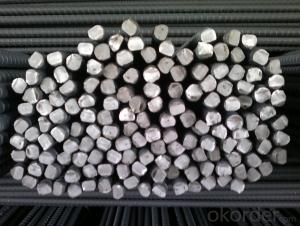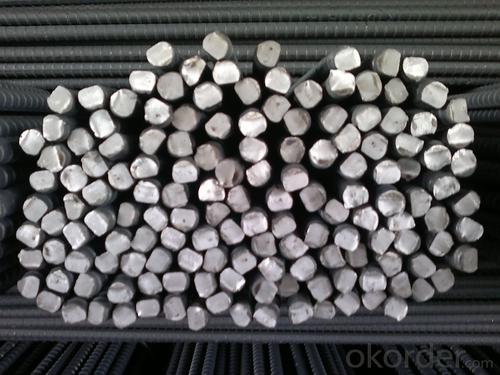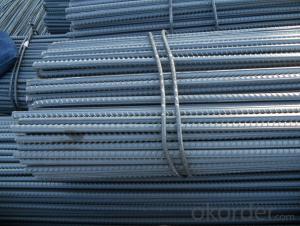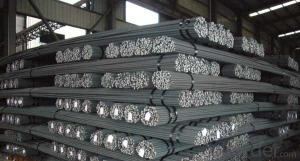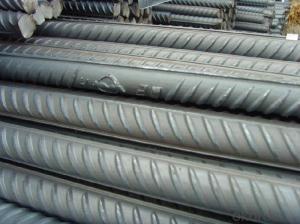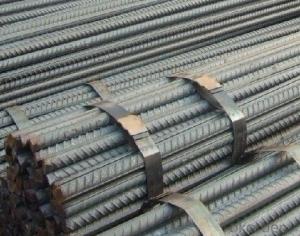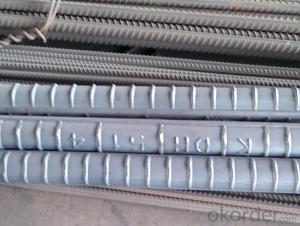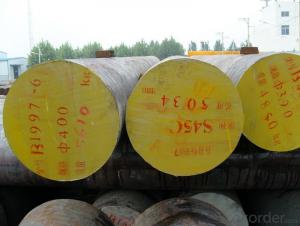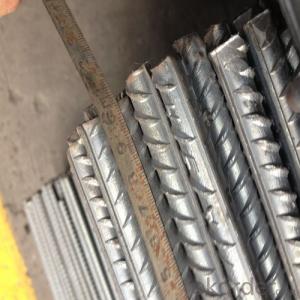Deformed steel bar HPB400;HPB500
- Loading Port:
- Tianjin
- Payment Terms:
- TT OR LC
- Min Order Qty:
- 1000 m.t.
- Supply Capability:
- 10000 m.t./month
OKorder Service Pledge
OKorder Financial Service
You Might Also Like
Product Description:
Specifications of Deformed Steel Bar:
Standard | GB | HRB335, HRB400, HRB500 | |
UK | G460B, B500A, B500B,B500C | ||
USA | GR40, GR60 | ||
Diameter | 6mm,8mm,10mm,12mm,14mm,16mm,18mm,20mm, 22mm,25mm,28mm,32mm,36mm,40mm,50mm | ||
Length | 6M, 9M,12M or as required | ||
Place of origin | Hebei, China mainland | ||
Application | building,construction,road,bridge etc | ||
Brand name | DRAGON | ||
Theoretical weight and section area of each diameter as below for your information:
Diameter(mm) | Section area (mm²) | Mass(kg/m) |
6 | 28.27 | 0.222 |
8 | 50.27 | 0.395 |
10 | 78.54 | 0.617 |
12 | 113.1 | 0.888 |
14 | 153.9 | 1.21 |
16 | 201.1 | 1.58 |
18 | 254.5 | 2.00 |
20 | 314.2 | 2.47 |
22 | 380.1 | 2.98 |
25 | 490.9 | 3.85 |
28 | 615.8 | 4.83 |
32 | 804.2 | 6.31 |
36 | 1018 | 7.99 |
40 | 1257 | 9.87 |
50 | 1964 | 15.42 |
Usage and Applications of Deformed Steel Bar:
Deformed bar is widely used in buildings, bridges, roads and other engineering construction. Big to highways, railways, bridges, culverts, tunnels, public facilities such as flood control, dam, small to housing construction, beam, column, wall and the foundation of the plate, deformed bar is an integral structure material. With the development of world economy and the vigorous development of infrastructure construction, real estate, the demand for deformed bar will be larger and larger..
Packaging & Delivery of Deformed Steel Bar:
Packaging Detail: products are packed in bundle and then shipped by container or bulk vessel, deformed bar is usually naked strapping delivery, when storing, please pay attention to moisture proof. The performance of rust will produce adverse effect.
Each bundle weight: 2-3MT, or as required
Payment term: TT or L/C
Delivery Detail: within 45 days after received advanced payment or LC.
Label: to be specified by customer, generally, each bundle has 1-2 labels
Trade terms: FOB, CFR, CIF
- Q: How do steel rebars impact the overall construction cost estimation process?
- Steel rebars have a significant impact on the overall construction cost estimation process. These reinforcing bars are crucial components in reinforced concrete structures, providing strength and durability to the building. As such, their inclusion in cost estimation is essential for accurately assessing the total project cost. Firstly, steel rebars contribute to the material cost of the construction project. Since rebars are typically priced based on weight, the quantity and size of rebars required for the structure directly affect the material cost estimation. The accurate identification and quantification of rebars are necessary to ensure an appropriate budget allocation for the project. Moreover, steel rebars also influence the labor cost estimation. Installing rebars requires skilled labor, and the time and effort involved in cutting, bending, and placing the rebars must be considered. The complexity of the reinforcement design, such as intricate shapes or complex detailing, can increase labor costs. Therefore, accurate estimation of rebars allows for better planning of labor resources and cost allocation. In addition to material and labor costs, steel rebars impact other aspects of the construction cost estimation process. For instance, the weight and placement of rebars affect the structural design, which can influence the cost estimation of the concrete mix design and formwork requirements. The size and spacing of rebars may also impact the excavation and foundation costs, as well as the overall project timeline. Furthermore, steel rebars contribute to the long-term costs of the construction project. The quality and durability of rebars directly affect the lifespan and maintenance requirements of the structure. Investing in high-quality rebars can reduce future maintenance and repair costs, as well as enhance the overall life cycle cost analysis of the project. In conclusion, steel rebars have a significant impact on the overall construction cost estimation process. Accurate estimation of rebars is essential for determining the material and labor costs, as well as influencing other cost-related aspects of the project. It allows for precise budget allocation, resource planning, and consideration of long-term costs, ultimately leading to a more reliable and comprehensive construction cost estimation.
- Q: What are the factors that can cause steel rebars to corrode prematurely?
- There are several factors that can contribute to the premature corrosion of steel rebars. These include exposure to moisture, high levels of chloride ions, carbonation of concrete, inadequate concrete cover, poor quality of concrete or protective coatings, and the presence of other aggressive chemicals such as sulfates or acids. Environmental conditions, such as high humidity, coastal areas, or industrial environments, can also accelerate the corrosion process. Additionally, improper construction practices, such as inadequate compaction or curing of concrete, can lead to the initiation and progression of corrosion in steel rebars.
- Q: Are steel rebars suitable for use in high-temperature applications?
- High-temperature applications are generally not suitable for the use of steel rebars. Despite being a strong and durable material, steel has limitations when exposed to high temperatures. It can undergo a significant reduction in strength and even a loss of structural integrity, leading to potential failures. When subjected to high temperatures, steel goes through a process known as thermal expansion, which can weaken and deform it. This phenomenon is particularly noticeable in rebars, which are commonly used to reinforce concrete structures. The high temperatures cause the rebars to expand, exerting excessive pressure on the surrounding concrete. This pressure can result in cracks and potentially compromise the stability of the structure. Furthermore, prolonged exposure to high temperatures can cause a loss of the steel's mechanical properties, including its tensile strength and load-bearing capacity. As a result, the rebars become less effective in resisting external forces and reinforcing the concrete. For this reason, it is generally recommended to consider alternative materials, such as stainless steel or special alloys, for high-temperature applications. These materials are specifically designed to withstand elevated temperatures without compromising their structural integrity. To ensure safety and structural stability, it is important to consult with experts and engineers who are familiar with high-temperature applications in order to determine the most suitable materials for specific projects.
- Q: What is the difference between carbon steel and stainless steel rebars?
- Both carbon steel and stainless steel rebars are utilized in construction as types of steel reinforcement. However, they differ significantly in their composition and properties. Carbon steel rebars consist of a combination of iron and carbon, with trace amounts of other elements like manganese and copper. The carbon content in these rebars typically ranges from 0.15% to 0.60%. They possess strength, durability, and cost-effectiveness. Their tensile strength is crucial for reinforcing concrete structures. Nevertheless, they are prone to corrosion if not adequately protected, especially in environments with high moisture or exposure to chemicals. On the contrary, stainless steel rebars are created by combining iron, chromium, nickel, and other alloying elements. The chromium content in stainless steel usually exceeds 10.5%, leading to the formation of a protective layer of chromium oxide on the rebar's surface, which prevents corrosion. Stainless steel rebars exhibit exceptional corrosion resistance, even in harsh environments with high humidity, saltwater, or exposure to chemicals. Additionally, they are highly durable and possess high tensile strength, similar to carbon steel rebars. The primary distinction between carbon steel and stainless steel rebars lies in their corrosion resistance. Carbon steel rebars necessitate the application of protective coatings like epoxy or galvanization to prevent corrosion. In contrast, stainless steel rebars possess inherent corrosion resistance due to the presence of the chromium oxide layer, eliminating the need for additional coatings. Another differing factor is the cost. Carbon steel rebars are generally more affordable compared to stainless steel rebars. However, the total project cost should also consider the long-term maintenance expenses associated with corrosion protection measures required for carbon steel rebars. To summarize, carbon steel rebars are strong and cost-effective but require supplementary corrosion protection, while stainless steel rebars exhibit excellent corrosion resistance and durability at a higher cost. The selection between the two depends on the specific project requirements, budget constraints, and anticipated environmental conditions.
- Q: What is the role of steel rebars in preventing structural vibrations?
- The role of steel rebars in preventing structural vibrations is to provide reinforcement and increase the stiffness of concrete structures. Steel rebars are embedded within the concrete, forming a skeletal framework that enhances the structural integrity and reduces the risk of vibrations. When a load or force is applied to a structure, such as wind or seismic activity, it can cause the structure to vibrate. These vibrations can lead to structural damage or even collapse if left unchecked. Steel rebars help mitigate these vibrations by absorbing and distributing the forces throughout the structure. By reinforcing the concrete, steel rebars increase the stiffness and strength of the structure, thereby reducing the amplitude of vibrations. They help to resist bending and torsional forces, ensuring that the structure remains stable and secure under various load conditions. Furthermore, steel rebars also play a crucial role in preventing progressive collapse. In the event of localized damage or failure, the rebars act as a safety net, redistributing the load and preventing a complete collapse. This is particularly important in high-rise buildings or structures with complex geometries, where the consequences of structural failure can be catastrophic. Overall, the presence of steel rebars in concrete structures significantly enhances their ability to withstand vibrations and external forces, ensuring the safety and longevity of the structure.
- Q: How are steel rebars measured?
- Steel rebars are measured using a standardized system known as the "bar size number." This system assigns a numerical value to each rebar size, which corresponds to the diameter of the rebar. The diameter is measured in inches or millimeters, depending on the region or country. In the United States, the bar size number is used, which ranges from #3 to #18. The number indicates the diameter of the rebar in eighths of an inch. For instance, a #3 rebar has a diameter of 3/8 inch, while a #8 rebar has a diameter of 1 inch. Beyond #8, the diameter is measured in quarters of an inch. For example, a #11 rebar has a diameter of 1 1/8 inches, and a #18 rebar has a diameter of 2 1/4 inches. In metric countries, rebars are measured using millimeters. The diameter is typically rounded to the nearest millimeter. For instance, a 10 mm rebar is equivalent to a #3 rebar in the US, and a 25 mm rebar is equivalent to a #8 rebar. To measure the length of a rebar, a tape measure or ruler is used. The length is typically measured in feet or meters. Rebars are commonly available in lengths of 20 or 40 feet (6 or 12 meters), but they can also be cut to custom lengths as per project requirements. It is important to note that the measurement system may vary slightly in different regions or countries, so it is crucial to consult local standards and codes for accurate measurement guidelines.
- Q: Are steel rebars susceptible to rusting?
- Yes, steel rebars are susceptible to rusting.
- Q: Thread steel generally used for more?
- Bars of 6.59 mm in diameter, most of which are rolled into strips; 1040 mm in diameter, usually
- Q: How do steel rebars affect the overall flexibility of a structure?
- Steel rebars greatly enhance the overall flexibility of a structure. By reinforcing the concrete, rebars provide additional tensile strength, allowing the structure to better withstand external forces such as wind, earthquakes, or heavy loads. This added flexibility prevents cracking and structural failure, ensuring the longevity and safety of the building.
- Q: Can steel rebars be used in historical buildings restoration?
- Indeed, the utilization of steel rebars is applicable in the restoration of historical buildings. These rebars, commonly employed in construction, are capable of providing structural reinforcement to fortify the existing structures of such buildings. Through careful implementation, the integration of steel rebars can effectively restore stability and integrity while preserving the historical significance of these structures. Nevertheless, it is crucial to consider the specific requirements and guidelines for restoring historical buildings, thus ensuring that the use of steel rebars does not compromise the authenticity or aesthetic value of the structure. Successful incorporation of steel rebars in the restoration process necessitates proper planning, consultation with preservation experts, and adherence to conservation principles.
Send your message to us
Deformed steel bar HPB400;HPB500
- Loading Port:
- Tianjin
- Payment Terms:
- TT OR LC
- Min Order Qty:
- 1000 m.t.
- Supply Capability:
- 10000 m.t./month
OKorder Service Pledge
OKorder Financial Service
Similar products
Hot products
Hot Searches
Related keywords
